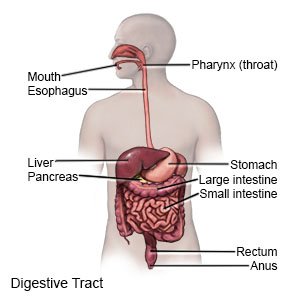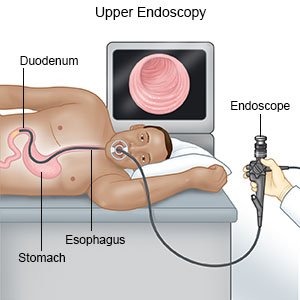Esophageal Foreign Body
Medically reviewed by Drugs.com. Last updated on Aug 4, 2025.
What is an esophageal foreign body?
An esophageal foreign body is an object you swallowed that got stuck in your esophagus (throat). Examples include dental work and button batteries. A piece of food or a fish bone can also become stuck in your esophagus. Your risk increases if you wear dentures, have trouble swallowing, or have a narrow esophagus. You also have a higher risk if you eat fish that contains small bones.
 |
What are the signs and symptoms of an esophageal foreign body?
- Pain when you swallow, trouble swallowing, or a sore throat
- Drooling or vomiting
- Choking or gagging
- Chest pain, abdominal pain, or a feeling that something is in your throat
- A cough or noisy breathing
How may an esophageal foreign body be found?
Your healthcare provider will examine your throat, chest, and abdomen. Tell your provider the type of object you swallowed and when you swallowed it. Your provider may use any of the following to find the object:
- A barium swallow or other x-rays may be used to check your neck, chest, and abdomen. You will drink thick liquid called barium while healthcare providers take x-rays. Barium helps your esophagus and stomach show up on x-rays.
- Laryngoscopy is used to examine the back of your throat. A laryngoscope is a thin, flexible tube that is inserted through your mouth to the back of your throat. Your provider may also use a light and a mirror.
- A metal detector may be used to look for coins or other metal objects in your body.
- A CT scan or x-rays may be used to check for objects in your esophagus or stomach. You may be given contrast liquid to help your esophagus and stomach show up better. Tell the provider if you have ever had an allergic reaction to contrast liquid.
- Endoscopy may be used to see the lower part check your esophagus. A scope is a long, bendable tube with a light on the end of it. A camera attached to the scope will take pictures. The object may be removed during the endoscopy.

How may an esophageal foreign body be removed?
Your healthcare provider may choose to observe you for 24 hours or longer. Most objects pass through the digestive system on their own within 7 to 10 days. Objects that are small or smooth will often pass without a problem. You will need to search for the object every time you have a bowel movement. Do not use laxatives or stool softeners. Do not force yourself to vomit. Your provider may try to remove the object with any of the following:
- Forceps may be used to grab an object if your provider can see it in the back of your throat. Forceps also may be used to remove an object during endoscopy.
- Bougienage is a procedure used to push the object into your stomach. Your provider will insert a thin tube into your esophagus to widen it. This may be done if the object is smooth and likely to pass through your digestive system normally.
- A balloon catheter may be used to pull the object out of your esophagus. The catheter is a thin tube with a deflated balloon at the end. Your provider will insert the balloon catheter into your mouth or nose until it goes past the object. The balloon will then be inflated. This procedure may be done if the object is smooth or blunt.
- Surgery may be needed if the object cannot be removed another way.
Call your local emergency number (911 in the US) or have someone call if:
- You have chest or abdominal pain, or shortness of breath.
- You are choking.
When should I seek immediate care?
- You have a fever.
- You have more pain when you swallow.
- You cannot stop vomiting.
- Your vomit is bloody.
- Your bowel movements are black or bloody.
When should I call my doctor?
- You do not find the object in your bowel movement within 3 days.
- You have questions or concerns about your condition or care.
Care Agreement
You have the right to help plan your care. Learn about your health condition and how it may be treated. Discuss treatment options with your healthcare providers to decide what care you want to receive. You always have the right to refuse treatment. The above information is an educational aid only. It is not intended as medical advice for individual conditions or treatments. Talk to your doctor, nurse or pharmacist before following any medical regimen to see if it is safe and effective for you.© Copyright Merative 2025 Information is for End User's use only and may not be sold, redistributed or otherwise used for commercial purposes.
Learn more about Esophageal Foreign Body
Care guides
Further information
Always consult your healthcare provider to ensure the information displayed on this page applies to your personal circumstances.
